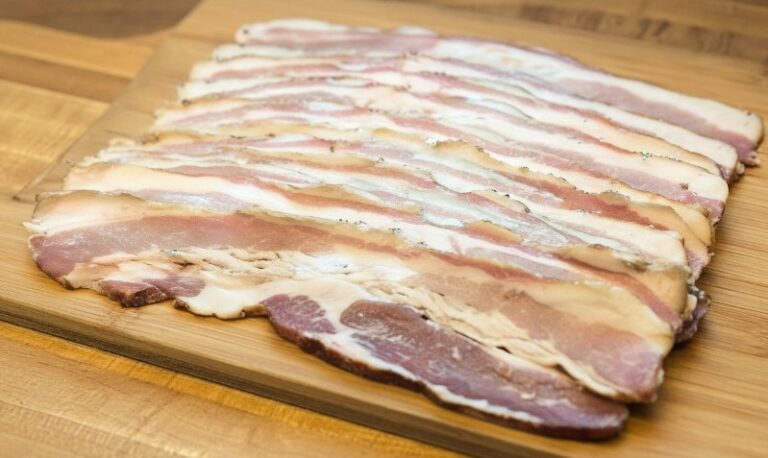There’s a certain heartbreak in opening the fridge, spotting that half-used pack of bacon, and asking yourself the big question: “Is it still good?” Bacon sits in a tricky category. It’s cured, sometimes smoked, and rich in fat that locks in flavor for days.
Yet, it’s also raw meat unless labeled shelf-stable. That means food safety rules still apply, no matter how much salt or smoke went into it.
So let’s walk through the reliable ways to check whether bacon deserves a spot in the skillet or needs to go straight to the bin. The signs are clear once you know what to look, smell, and feel for.
Key Points
- Sour or rancid smell, slime, or discoloration means bacon is unsafe – toss it.
- Opened raw bacon lasts 7 days in the fridge; cooked bacon lasts 4–5 days.
- Smell, feel, and packaging are more reliable than date labels.
- Always refrigerate quickly and never keep bacon out for over 2 hours.
The Short Answer Before the Details
If bacon smells sour or rancid, feels slimy or tacky, or shows mold, it’s time to toss it. No exceptions.
Time limits matter just as much as the sensory checks. Once opened, raw bacon keeps about seven days in the refrigerator at 4 °C (about 40 °F ) and one month in the freezer for best quality. Cooked bacon lasts around four to five days in the fridge and roughly a month frozen.
Government food safety sources like the USDA and FoodSafety.gov are consistent: “ When in doubt, throw it out. ”
How Long Bacon Lasts
Here’s the overview you should always keep in mind before sniffing or inspecting.
| Bacon Type | Fridge (≤ 4 °C) | Freezer (≤ −18 °C) | Notes |
| Raw bacon, unopened | About 1 week | About 1 month for best quality | Once opened, the 7-day clock applies |
| Raw bacon, opened | 7 days | About 1 month for best quality | Keep tightly wrapped and cold |
| Cooked bacon | 4–5 days | About 1 month for best quality | Cool quickly and store airtight |
| Shelf-stable precooked bacon* | Follow package date when unopened | Not required | After opening, refrigerate and follow 4–5 day rule |
Some precooked bacon is formulated to be shelf-stable by reducing water activity to 0.85 or below . After opening, treat it like any ready-to-eat product and keep it chilled.
A note for power outages
If the power’s out for more than four hours and the fridge door has been opened, assume refrigerated bacon is unsafe. Once meat warms above 4 °C , bacteria can multiply fast enough to make it risky to keep.
The 9 Clues You Can Trust
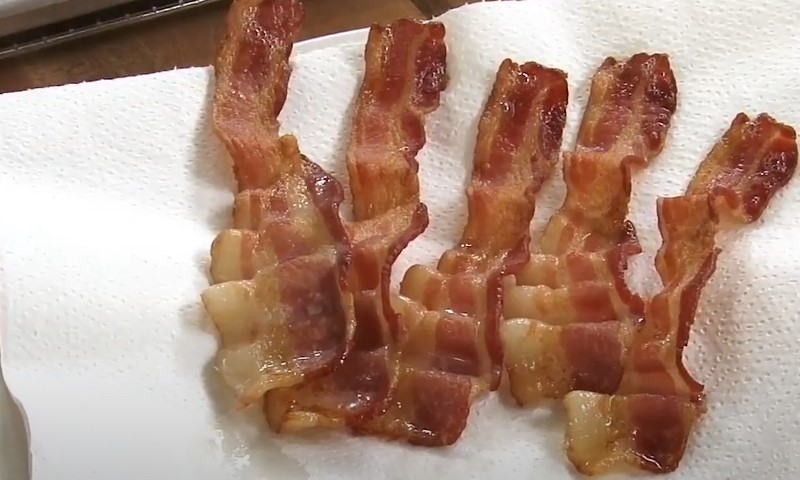
Think of checking bacon like a three-step test: look, smell, feel. Fail one, and it’s over. You don’t need fancy equipment, just your senses and a willingness to toss questionable meat without hesitation.
1. A sour or rancid smell
Fresh bacon smells meaty, salty, and sometimes smoky. Spoiled bacon smells sour, fishy, or like old paint. That “paint” smell is the fat turning rancid as oxygen breaks down the lipids.
If your nose wrinkles, don’t rationalize it.
Off odors are one of the clearest spoilage signals cited by food safety authorities. A bad smell alone is enough reason to let it go.
2. Surface slime or tackiness
A clean slice of bacon should feel moist but never slick. If it feels slimy or sticky, it’s a bacterial biofilm forming, essentially a layer of bacterial growth producing gums on the surface.
Once that texture develops, there’s no saving it. The same goes for tackiness that clings to your fingers.
3. Color changes paired with odor or slime
Bacon’s normal color runs from pink to red, thanks to curing reactions that form nitrosyl-hemochrome, a stable rosy pigment. Edges might fade slightly over time; that’s normal oxidation.
What’s not normal is when that rosy tone dulls into brown or gray, and there’s a bad smell or slime present.
Color change plus odor equals discard. Simple as that.
4. Greenish shimmer vs true spoilage colors
You might sometimes see a rainbow sheen when light hits sliced meat, especially steaks and bacon. That’s a diffraction effect, not decay. It’s like seeing oil slick colors on a puddle; it’s optical, not bacterial.
However, dull green or gray-green patches, especially paired with odor or moisture, point to spoilage.
5. Mold
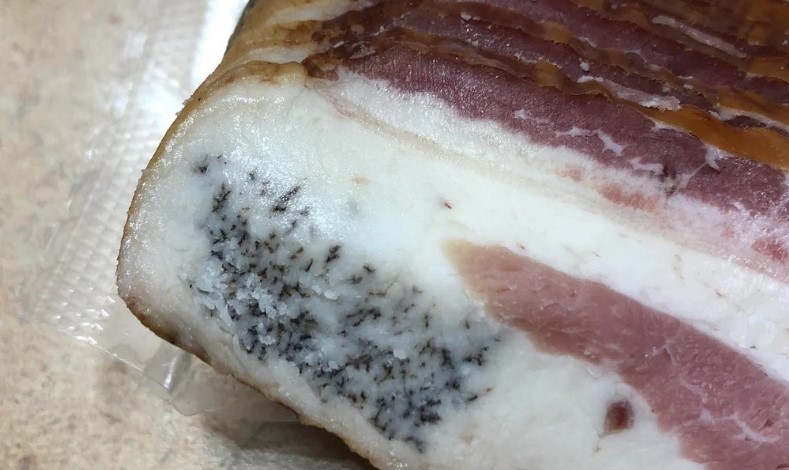
White, blue, or black fuzzy growth is a full stop. Mold signals moisture and time: two things bacon shouldn’t have too much of. You can’t trim it away safely. Just toss it.
6. Package problems
Packaging tells you more than people think. If a vacuum seal is broken or a pack looks puffed up, oxygen or bacteria might have entered. That means oxidation, gas buildup, and spoilage.
When you open a pack and the purge (that small bit of liquid inside) smells sour or sulfurous, don’t risk it even if the date looks fine. Packaging failure trumps the calendar.
7. Time and temperature violations
Even perfect-looking bacon is unsafe if it sits out for hours. The two-hour rule applies to all perishable foods: if bacon has been at room temperature beyond two hours, it’s done.
During a power outage longer than four hours, or if the fridge temp climbed above 4 °C, discard anything perishable, including bacon.
8. Post-cook hold problems
Cooked bacon left sitting out for hours after brunch can grow toxin-forming bacteria. Always cool and refrigerate within two hours. Once chilled, the four-to-five-day rule applies.
9. Date labels and what they really mean
“Best if Used By” and “Sell By” dates talk about quality , not safety. Bacon doesn’t magically spoil at midnight on the date printed. But once that date passes, flavor and texture can degrade faster.
If you see “Use By,” that one is stricter; it’s the manufacturer’s recommended final day for both quality and safety. Respect that one. Otherwise, combine label reading with your sensory check.
Why the Smell and Feel Tests Work
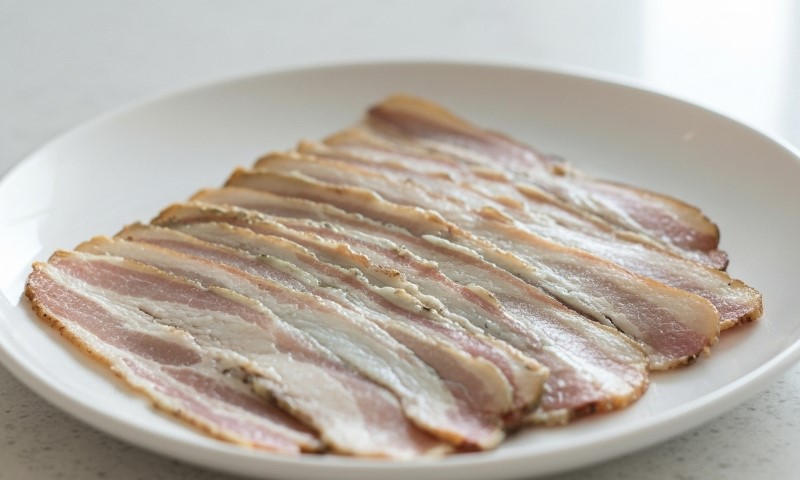
Bacon spoilage starts microscopically before you see major color shifts. Microbes and oxidation alter aroma and texture long before obvious mold appears.
Bacteria feed on fats and proteins, releasing volatile compounds that smell sour, fishy, or rotten.
Meanwhile, oxygen exposure oxidizes bacon fat, creating aldehydes and ketones, the same chemicals that make old paint or rancid nuts smell off.
That’s why the smell test is so trustworthy. Once that distinctive tang hits your nose, the spoilage process is already advanced.
Slime forms from bacterial exopolysaccharides, natural gums that trap moisture. It’s one of the easiest visual cues that bacteria are active. You can’t wash it off safely.
So while expiration dates are helpful, your nose and fingertips remain your best early-warning tools.
Why Bacon Stays Pink Even When Cooked
Don’t let color fool you into thinking bacon is raw. During curing, sodium nitrite reacts with muscle pigments to form nitrosyl-hemochrome , a stable rosy compound that stays pink even after cooking.
That’s why cured meats, such as ham, bacon, and some sausages, retain a reddish hue after heating. It’s chemistry, not undercooking.
Your 30-Second Bacon Safety Check
You don’t need to overthink it. Run through this quick checklist every time you reach for the pack.
1. Check the calendar
- Opened raw bacon older than 7 days: discard.
- Cooked bacon older than 5 days: discard.
- Power outage longer than 4 hours: discard refrigerated bacon.
2. Inspect the package
- Broken seals, torn film, or puffed packaging mean discard.
- Sour smell from liquid in the pack is another no.
3. Look
- Healthy: pink-red color, dry surface.
- Bad: brown, gray, green, mold, or desiccated edges with odor.
4. Smell
- Fresh: salty, smoky, savory.
- Spoiled: sour, rancid, fishy, or paint-like.
5. Touch
- Clean and slightly moist is fine.
- Slimy or sticky means bacteria are active – discard immediately.
Handling Habits That Keep Bacon Good Longer
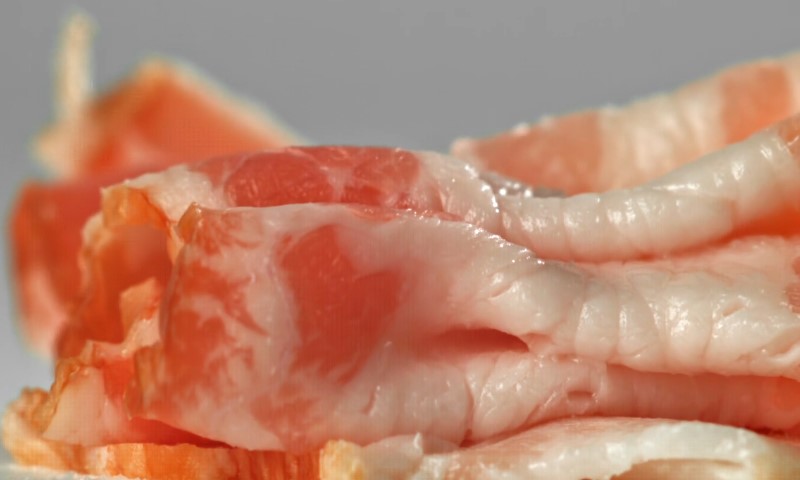
Most spoilage comes down to poor handling after purchase. A few small tweaks extend bacon’s life significantly.
Buy and chill smart
Pick up bacon near the end of your grocery run so it spends less time warm. Keep it in a chilled or insulated bag until you get home.
Store it immediately in the coldest refrigerator zone, often the back bottom shelf.
Place it on a tray to catch drips and prevent contact with ready-to-eat foods. Food safety guidelines emphasize the separation of raw meat from produce and cooked foods.
Open, portion, and wrap tightly
Once you open the package, air exposure speeds up oxidation and bacterial growth. Press out as much air as possible before resealing. Use a zipper bag or wrap in plastic, then foil for extra protection.
If you won’t finish it in a few days, divide it into smaller portions and freeze. Even though frozen bacon remains safe indefinitely below −18 °C, quality drops after about a month due to fat oxidation and freezer burn.
Freeze smarter
That way, you can grab only what you need later without defrosting the whole batch. Label with the date to keep track of rotation.
Cook completely the first time
Partial cooking followed by refrigeration encourages bacterial survival. Cook bacon fully the first time, then either hold it hot for serving or cool and store it quickly. Food safety documents repeatedly caution against “par-cooking” meat for later finishing.
Cool and store cooked bacon right
After cooking, move slices to clean paper towels to drain, then refrigerate within two hours in a shallow, sealed container. Eat within four to five days, or freeze up to a month for the best quality.
Special Cases You Might Be Curious About
Some bacon products don’t play by the same rules. Shelf-stable strips, bacon bits, and date labels each have quirks worth knowing before you decide how to store or use them.
Shelf-stable precooked bacon
Some brands make bacon that doesn’t need refrigeration before opening. They achieve this by lowering water activity to 0.85 or less and applying validated heat treatment.
Once opened, though, it’s no longer shelf-stable. Keep it refrigerated and use it within several days, following the same rules as any cooked meat.
Bacon bits
Real bacon bits that are shelf-stable are processed under similar conditions as shelf-stable strips, low moisture, and heat-treated. After opening, refrigerate them to maintain quality.
Plant-based imitation bits follow separate label rules but still benefit from airtight storage and cool temperatures once opened. Always check for off odors or stale fat smells.
Date labels
Regulatory agencies encourage standardized wording like “Best if Used By” to reduce food waste. A “Use By” date is the strictest; it marks the last day recommended for safe use.
Still, time and temperature handling override dates. If bacon has been left out or warmed too long, it’s unsafe even if the date hasn’t arrived.
Why All This Caution Matters
@thereneereina Best before dates & bacon. #kitchenquestions #cookingtiktok #relatable #learningtocook #bacon #foodsafety #foodtiktok
Foodborne illness is no small problem. The CDC estimates 48 million illnesses , 128,000 hospitalizations , and 3,000 deaths every year from foodborne pathogens.
Meat and poultry contribute heavily to those numbers. Bacon’s curing process slows bacteria, but it doesn’t sterilize the meat.
Mistakes like leaving it out too long or ignoring subtle odor changes can turn a simple breakfast into a health risk.
The good news? Most of those risks are preventable. Paying attention to smell, feel, and time keeps your food safe without relying on guesswork.
Resolving Common Scenarios
Here’s how to handle those gray-area fridge moments.
- The bacon looks fine, but smells slightly sour. – Trust your nose. Smell outweighs appearance. Toss it.
- An open pack has been in the fridge for 10 days, with no smell. – Still toss it. The 7-day safety window is up, even if it passes the sniff test.
- You see a rainbow sheen under light. – No odor or slime? It’s likely harmless iridescence. Safe to cook.
- Cooked bacon sat on the brunch table all morning. – Over two hours unrefrigerated? Discard it.
- The power outage lasted all afternoon. – More than four hours with a warm fridge? Discard all refrigerated meat, including bacon.
The Bottom Line
You don’t need lab gear or fancy sensors to decide whether bacon’s still good. Your senses and a little discipline are enough.
Stick to the fundamentals:
- Clean, meaty smell
- No slime or stickiness
- Normal cured pink color
- Tight packaging
- Proper time and temperature
Cured meat has resilience, but it isn’t invincible. A quick check before breakfast keeps you from risking foodborne illness later. When in doubt, throw it out. Bacon’s joy isn’t worth gambling over.

